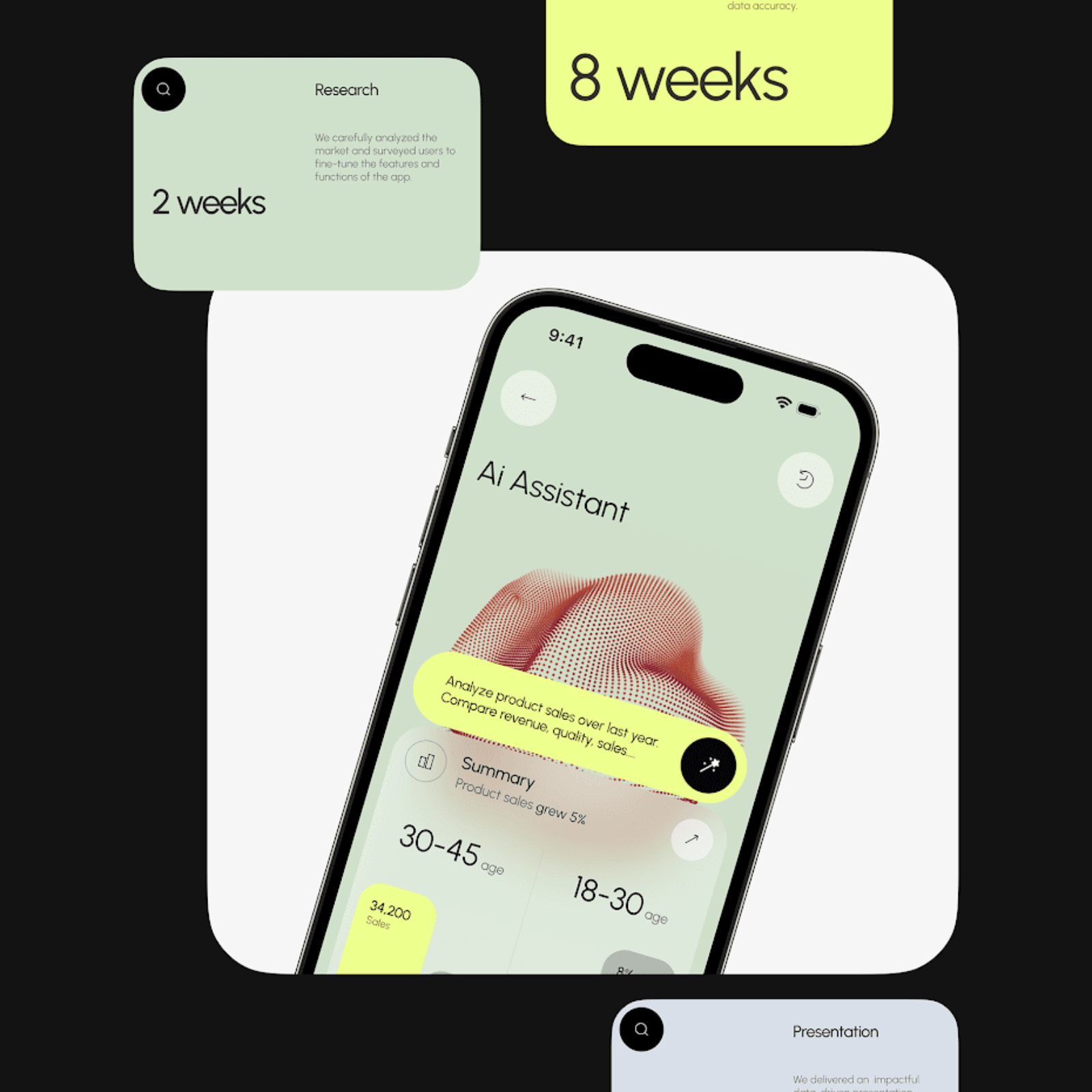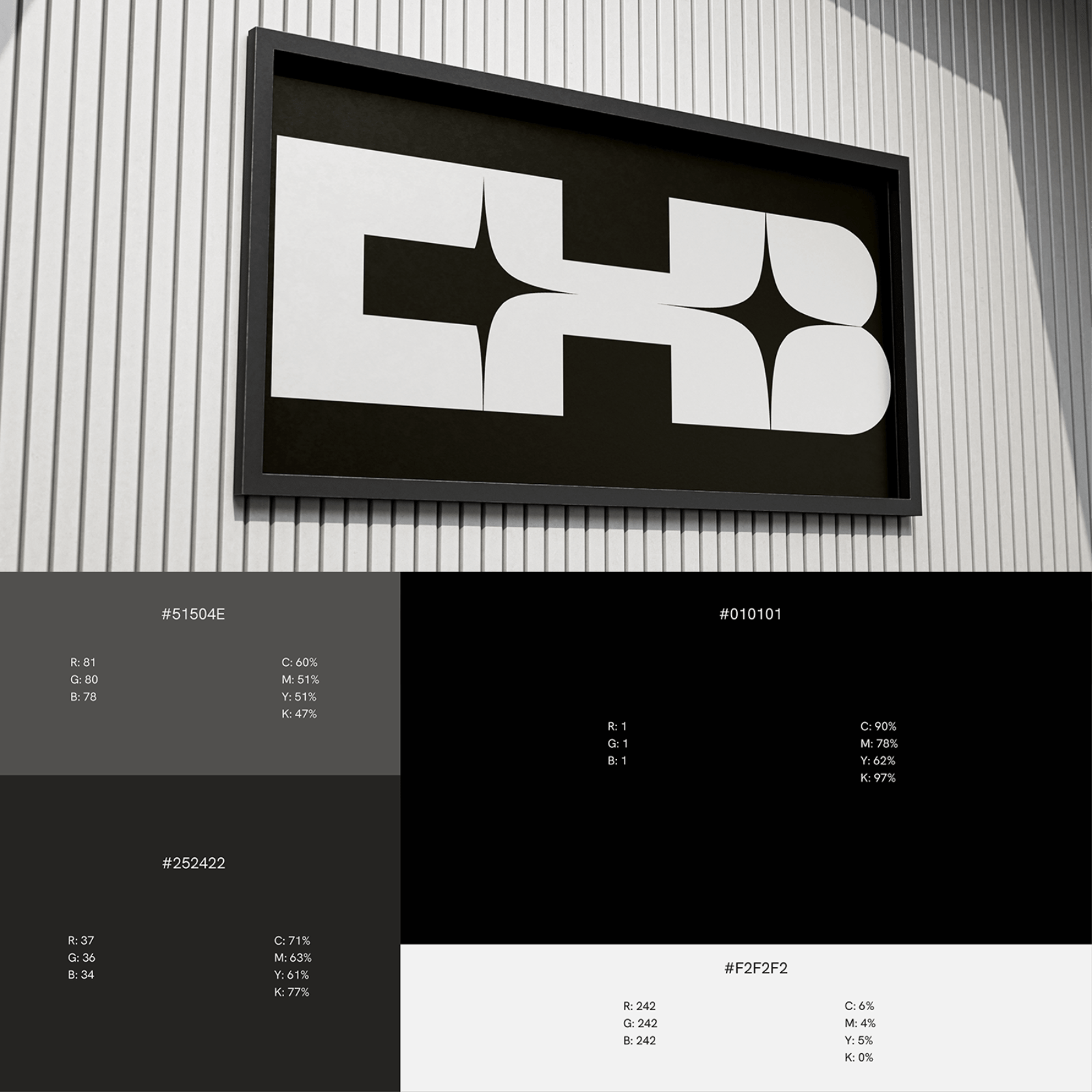Collective #835
Original Source: https://tympanus.net/codrops/collective/collective-835/
Latency numbers every frontend developer should know * Putting React In The Browser * Franken UI
This author has not written his bio yet.
But we are proud to say that admin contributed 3983 entries already.
Original Source: https://tympanus.net/codrops/collective/collective-835/
Latency numbers every frontend developer should know * Putting React In The Browser * Franken UI
Original Source: https://abduzeedo.com/exploring-sisense-ai-assistants-ux-and-branding-excellence
Exploring Sisense AI Assistant’s UX and Branding Excellence

abduzeedo0502—24
Discover how Sisense AI Assistant excels in SaaS and UX/UI design, enhancing user experience with smart branding and intuitive interfaces. Learn from this UX case study.
In the ever-evolving world of business intelligence, standing out through innovative design is paramount. The Sisense AI Assistant, designed by Rondesignlab, is an exemplar of effective UX/UI design tailored for the SaaS sector. This UX case study dives into how Sisense leverages robust design principles to enhance data interaction and user engagement.
Sisense, a seasoned player in the business intelligence software arena, offers a powerful platform that transforms diverse data sets into actionable insights and interactive reports. At the core of Sisense’s strategy is a commitment to user-friendly design, which allows users to easily navigate massive datasets and derive meaningful patterns and trends.
One standout feature is the AI-powered data exploration tool, which intelligently analyzes user behavior to recommend relevant data points and visualizations. This proactive approach not only enhances the analytical process but also customizes the user experience, making it more intuitive and responsive.
Further solidifying its market position is Sisense’s strong brand identity. The logo, featuring a bold and modern typeface, acts as a visual anchor, communicating the software’s cutting-edge capabilities. More than just a logo, it is part of a comprehensive brand strategy that includes detailed guidelines covering the use of logos, fonts, colors, and overall brand voice. These guidelines ensure that every point of communication is coherent, reflecting the sophistication and clarity of Sisense as a brand.
For designers and developers involved in SaaS projects, the Sisense AI Assistant serves as an inspiring benchmark. It showcases how strategic design can facilitate better data management and decision-making processes. By prioritizing clarity and user adaptability, Sisense not only meets the analytical needs of its users but also ensures that interactions with the platform are seamless and productive.
This case study exemplifies how integrating AI with thoughtful UX design can revolutionize user interaction within business intelligence tools. For those looking to enhance their platforms, it offers valuable lessons in balancing functionality with aesthetic precision, ensuring that every user experience is both engaging and efficient.
Branding and UX design artifacts
For more information make sure to check out Rondesignlab at https://rondesignlab.com/
Original Source: https://www.webdesignerdepot.com/ai-predict-design-trends/
Design trends evolve at a blistering pace, especially in web design. On multi-month projects, you might work on a cutting-edge design after the kick-off meeting, only to launch a dated-looking site.
Original Source: https://www.sitepoint.com/cloud-native-how-ampere-is-improving-nightly-arm64-builds/?utm_source=rss

Learn how the CNCF make their nightly native arm64 builds more secure, more efficiently use resources, and be much faster.
Continue reading
Cloud Native: How Ampere Is Improving Nightly Arm64 Builds
on SitePoint.
Original Source: https://smashingmagazine.com/2024/04/desktop-wallpaper-calendars-may-2024/
Inspiration lies everywhere, and as a matter of fact, we discovered one of the best ways to spark new ideas: desktop wallpapers. Since more than 13 years already, we challenge you, our dear readers, to put your creative skills to the test and create wallpaper calendars for our monthly wallpapers posts. No matter if you’re into illustration, lettering, or photography, the wallpapers series is the perfect opportunity to get your ideas flowing and create a small artwork to share with people all around the world. Of course, it wasn’t any different this month.
In this post, you’ll find desktop wallpapers created by artists and designers who took on the creativity challenge. They come in versions with and without a calendar for May 2024 and can be downloaded for free. As a little bonus goodie, we also compiled a selection of favorites from our wallpapers archives at the end of the post. Maybe you’ll spot one of your almost-forgotten favorites from the past in here, too? A big thank-you to everyone who shared their designs with us this month! Happy May!
You can click on every image to see a larger preview,
We respect and carefully consider the ideas and motivation behind each and every artist’s work. This is why we give all artists the full freedom to explore their creativity and express emotions and experience through their works. This is also why the themes of the wallpapers weren’t anyhow influenced by us but rather designed from scratch by the artists themselves.
Submit a wallpaper!
Did you know that you could get featured in our next wallpapers post, too? We are always looking for creative talent.
A Symphony Of Dedication On Labour Day
“On Labour Day, we celebrate the hard-working individuals who contribute to the growth of our communities. Whether in busy urban areas or peaceful rural settings, this day recognizes the unsung heroes driving our advancement. Let us pay tribute to the workers, craftsmen, and visionaries shaping our shared tomorrow.” — Designed by PopArt Studio from Serbia.

preview
with calendar: 320×480, 640×480, 800×480, 800×600, 1024×768, 1024×1024, 1152×864, 1280×720, 1280×800, 1280×960, 1280×1024, 1400×1050, 1440×900, 1600×1200, 1680×1050, 1680×1200, 1920×1080, 1920×1200, 1920×1440, 2560×1440
without calendar: 320×480, 640×480, 800×480, 800×600, 1024×768, 1024×1024, 1152×864, 1280×720, 1280×800, 1280×960, 1280×1024, 1400×1050, 1440×900, 1600×1200, 1680×1050, 1680×1200, 1920×1080, 1920×1200, 1920×1440, 2560×1440
Navigating The Amazon
“We are in May, the spring month par excellence, and we celebrate it in the Amazon jungle.” — Designed by Veronica Valenzuela Jimenez from Spain.

preview
with calendar: 640×480, 800×480, 1024×768, 1280×720, 1280×800, 1440×900, 1600×1200, 1920×1080, 1920×1440, 2560×1440
without calendar: 640×480, 800×480, 1024×768, 1280×720, 1280×800, 1440×900, 1600×1200, 1920×1080, 1920×1440, 2560×1440
Popping Into Spring
“Spring has sprung, and what better metaphor than toast popping up and out of a fun-colored toaster!” — Designed by Stephanie Klemick from Emmaus Pennsylvania, USA.

preview
with calendar: 320×480, 640×480, 800×480, 800×600, 1024×768, 1024×1024, 1152×864, 1280×720, 1280×800, 1280×960, 1280×1024, 1400×1050, 1440×900, 1600×1200, 1680×1050, 1680×1200, 1920×1080, 1920×1200, 1920×1440, 2560×1440
without calendar: 320×480, 640×480, 800×480, 800×600, 1024×768, 1024×1024, 1152×864, 1280×720, 1280×800, 1280×960, 1280×1024, 1400×1050, 1440×900, 1600×1200, 1680×1050, 1680×1200, 1920×1080, 1920×1200, 1920×1440, 2560×1440
Duck
Designed by Madeline Scott from the United States.

preview
with calendar: 320×480, 640×480, 800×480, 800×600, 1024×768, 1024×1024, 1152×864, 1280×720, 1280×800, 1280×960, 1280×1024, 1400×1050, 1440×900, 1600×1200, 1680×1050, 1680×1200, 1920×1080, 1920×1200, 1920×1440, 2560×1440
without calendar: 320×480, 640×480, 800×480, 800×600, 1024×768, 1024×1024, 1152×864, 1280×720, 1280×800, 1280×960, 1280×1024, 1400×1050, 1440×900, 1600×1200, 1680×1050, 1680×1200, 1920×1080, 1920×1200, 1920×1440, 2560×1440
Cruising Into Spring
“When I think of spring, I think of finally being able to drive with the windows down and enjoying the fresh air!” — Designed by Vanessa Mancuso from the United States.

preview
with calendar: 320×480, 480×800, 1024×768, 1024×1024, 1152×864, 1280×720, 1280×800, 1280×960, 1400×1050, 1440×900, 1600×1200, 1680×1050, 1680×1200, 1920×1080, 1920×1440, 2560×1440
without calendar: 320×480, 480×800, 1024×768, 1024×1024, 1152×864, 1280×720, 1280×800, 1280×960, 1400×1050, 1440×900, 1600×1200, 1680×1050, 1680×1200, 1920×1080, 1920×1440, 2560×1440
Lava Is In The Air
Designed by Ricardo Gimenes from Sweden.

preview
with calendar: 640×480, 800×480, 800×600, 1024×768, 1024×1024, 1152×864, 1280×720, 1280×800, 1280×960, 1280×1024, 1366×768, 1400×1050, 1440×900, 1600×1200, 1680×1050, 1680×1200, 1920×1080, 1920×1200, 1920×1440, 2560×1440, 3840×2160
without calendar: 640×480, 800×480, 800×600, 1024×768, 1024×1024, 1152×864, 1280×720, 1280×800, 1280×960, 1280×1024, 1366×768, 1400×1050, 1440×900, 1600×1200, 1680×1050, 1680×1200, 1920×1080, 1920×1200, 1920×1440, 2560×1440, 3840×2160
Love Myself
Designed by Design-Studio from India.

preview
with calendar: 1440×900, 1600×1200, 1680×1050, 1680×1200, 1920×1080, 1920×1200, 1920×1440, 2560×1440
without calendar: 1440×900, 1600×1200, 1680×1050, 1680×1200, 1920×1080, 1920×1200, 1920×1440, 2560×1440
Bat Traffic
Designed by Ricardo Gimenes from Sweden.

preview
with calendar: 640×480, 800×480, 800×600, 1024×768, 1024×1024, 1152×864, 1280×720, 1280×800, 1280×960, 1280×1024, 1366×768, 1400×1050, 1440×900, 1600×1200, 1680×1050, 1680×1200, 1920×1080, 1920×1200, 1920×1440, 2560×1440, 3840×2160
without calendar: 640×480, 800×480, 800×600, 1024×768, 1024×1024, 1152×864, 1280×720, 1280×800, 1280×960, 1280×1024, 1366×768, 1400×1050, 1440×900, 1600×1200, 1680×1050, 1680×1200, 1920×1080, 1920×1200, 1920×1440, 2560×1440, 3840×2160
Springtime Sips
“May is a month where the weather starts to warm and reminds us summer is approaching, so I created a bright cocktail-themed wallpaper since sipping cocktails in the sun is a popular warm weather activity!” — Designed by Hannah Coates from Baltimore, MD.

preview
with calendar: 320×480, 640×480, 800×480, 800×600, 1024×768, 1024×1024, 1152×864, 1280×720, 1280×800, 1280×960, 1280×1024, 1400×1050, 1440×900, 1600×1200, 1680×1050, 1680×1200, 1920×1080, 1920×1200, 1920×1440, 2560×1440
without calendar: 320×480, 640×480, 800×480, 800×600, 1024×768, 1024×1024, 1152×864, 1280×720, 1280×800, 1280×960, 1280×1024, 1400×1050, 1440×900, 1600×1200, 1680×1050, 1680×1200, 1920×1080, 1920×1200, 1920×1440, 2560×1440
Hello May
“The longing for warmth, flowers in bloom, and new beginnings is finally over as we welcome the month of May. From celebrating nature on the days of turtles and birds to marking the days of our favorite wine and macarons, the historical celebrations of the International Workers’ Day, Cinco de Mayo, and Victory Day, to the unforgettable ‘May the Fourth be with you’. May is a time of celebration — so make every May day count!” — Designed by PopArt Studio from Serbia.

preview
without calendar: 320×480, 640×480, 800×480, 800×600, 1024×768, 1024×1024, 1152×864, 1280×720, 1280×800, 1280×960, 1280×1024, 1366×768, 1440×900, 1440×1050, 1600×1200, 1680×1050, 1680×1200, 1920×1080, 1920×1200, 1920×1440, 2560×1440
ARRR2-D2
Designed by Ricardo Gimenes from Sweden.

preview
without calendar: 640×480, 800×480, 800×600, 1024×768, 1024×1024, 1152×864, 1280×720, 1280×800, 1280×960, 1280×1024, 1366×768, 1400×1050, 1440×900, 1600×1200, 1680×1050, 1680×1200, 1920×1080, 1920×1200, 1920×1440, 2560×1440, 3840×2160
May Your May Be Magnificent
“May should be as bright and colorful as this calendar! That’s why our designers chose these juicy colors.” — Designed by MasterBundles from Ukraine.

preview
without calendar: 320×480, 640×480, 800×480, 800×600, 1024×768, 1024×1024, 1152×864, 1280×720, 1280×800, 1280×960, 1280×1024, 1366×768, 1400×1050, 1440×900, 1600×1200, 1680×1050, 1680×1200, 1920×1080, 1920×1200, 1920×1440, 2560×1440
The Monolith
Designed by Ricardo Gimenes from Sweden.

preview
without calendar: 640×480, 800×480, 800×600, 1024×768, 1024×1024, 1152×864, 1280×720, 1280×800, 1280×960, 1280×1024, 1366×768, 1400×1050, 1440×900, 1600×1200, 1680×1050, 1680×1200, 1920×1080, 1920×1200, 1920×1440, 2560×1440, 3840×2160
Blooming May
“In spring, especially in May, we all want bright colors and lightness, which was not there in winter.” — Designed by MasterBundles from Ukraine.

preview
without calendar: 320×480, 640×480, 800×480, 800×600, 1024×768, 1024×1024, 1152×864, 1280×720, 1280×800, 1280×960, 1280×1024, 1366×768, 1400×1050, 1440×900, 1600×1200, 1680×1050, 1680×1200, 1920×1080, 1920×1200, 1920×1440, 2560×1440
The Mushroom Band
“My daughter asked me to draw a band of mushrooms. Here it is!” — Designed by Vlad Gerasimov from Georgia.

preview
without calendar: 800×480, 800×600, 1024×600, 1024×768, 1152×864, 1280×720, 1280×800, 1280×960, 1280×1024, 1366×768, 1400×1050, 1440×900, 1440×960, 1600×900, 1600×1200, 1680×1050, 1680×1200, 1920×1080, 1920×1200, 1920×1440, 2560×1440, 2560×1600, 2880×1800, 3072×1920, 3840×2160, 5120×2880
Poppies Paradise
Designed by Nathalie Ouederni from France.

preview
without calendar: 320×480, 1024×768, 1280×1024, 1440×900, 1680×1200, 1920×1200, 2560×1440
Lake Deck
“I wanted to make a big painterly vista with some mountains and a deck and such.” — Designed by Mike Healy from Australia.

preview
without calendar: 1280×960, 1440×900, 1680×1050, 1920×1080, 2560×1440, 2560×1600, 2880×1800
Make A Wish
Designed by Julia Versinina from Chicago, USA.

preview
without calendar: 320×480, 640×480, 800×480, 800×600, 1024×768, 1024×1024, 1152×864, 1280×720, 1280×800, 1280×960, 1280×1024, 1440×900, 1600×1200, 1680×1050, 1680×1200, 1920×1080, 1920×1200, 1920×1440, 2560×1440
Enjoy May!
“Springtime, especially Maytime, is my favorite time of the year. And I like popsicles — so it’s obvious isn’t it?” — Designed by Steffen Weiß from Germany.

preview
without calendar: 320×480, 640×480, 800×480, 800×600, 1024×768, 1024×1024, 1152×864, 1280×720, 1280×800, 1280×960, 1280×1024, 1400×1050, 1440×900, 1600×1200, 1680×1050, 1680×1200, 1920×1080, 1920×1200, 1920×1440, 2560×1440
Celestial Longitude Of 45°
“Lixia is the 7th solar term according to the traditional East Asian calendars, which divide a year into 24 solar terms. It signifies the beginning of summer in East Asian cultures. Usually begins around May 5 and ends around May 21.” — Designed by Hong, Zi-Cing from Taiwan.

preview
without calendar: 1024×768, 1080×1920, 1280×720, 1280×800, 1280×960, 1366×768, 1400×1050, 1680×1050, 1920×1080, 1920×1200, 2560×1440
Stone Dahlias
Designed by Rachel Hines from the United States.

preview
without calendar: 320×480, 640×480, 800×480, 800×600, 1024×768, 1024×1024, 1152×864, 1280×720, 1280×1024, 1366×768, 1400×900, 1400×1050, 1600×1200, 1680×1050, 1680×1200, 1920×1080, 1920×1200, 1920×1440, 2560×1440
Understand Yourself
“Sunsets in May are the best way to understand who you are and where you are heading. Let’s think more!” — Designed by Igor Izhik from Canada.

preview
without calendar: 1280×720, 1280×800, 1280×960, 1280×1024, 1400×1050, 1440×900, 1600×1200, 1680×1050, 1680×1200, 1920×1080, 1920×1200, 1920×1440, 2560×1440
Sweet Lily Of The Valley
“The ‘lily of the valley’ came earlier this year. In France, we celebrate the month of May with this plant.” — Designed by Philippe Brouard from France.

preview
without calendar: 800×480, 1024×768, 1024×1024, 1280×720, 1280×1024, 1440×900, 1920×1080, 1920×1440, 2560×1440
Today, Yesterday, Or Tomorrow
Designed by Alma Hoffmann from the United States.

preview
without calendar: 1024×768, 1024×1024, 1280×800, 1280×1024, 1366×768, 1440×900, 1680×1050, 1920×1080, 1920×1200, 2560×1440
Add Color To Your Life!
“This month is dedicated to flowers, to join us and brighten our days giving a little more color to our daily life.” — Designed by Verónica Valenzuela from Spain.

preview
without calendar: 800×480, 1024×768, 1152×864, 1280×800, 1280×960, 1440×900, 1680×1200, 1920×1080, 2560×1440
The Green Bear
Designed by Pedro Rolo from Portugal.

preview
without calendar: 1024×768, 1280×800, 1440×900, 1680×1200, 1920×1080, 2560×1440
Lookout At Sea
“I wanted to create something fun and happy for the month of May. It’s a simple concept, but May is typically the time to adventure out into the world and enjoy the best of Spring.” — Designed by Alexander Jubinski from the United States.

preview
without calendar: 320×480, 640×480, 800×480, 800×600, 1024×768, 1024×1024, 1152×864, 1280×720, 1280×800, 1280×960, 1280×1024, 1366×768, 1400×1050, 1440×900, 1600×1200, 1680×1050, 1680×1200, 1920×1080, 1920×1200, 1920×1440, 2560×1440
Tentacles
Designed by Julie Lapointe from Canada.

preview
without calendar: 320×480, 1024×768, 1280×800, 1280×1024, 1440×900, 1680×1050, 1920×1200
Spring Gracefulness
“We don’t usually count the breaths we take, but observing nature in May, we can’t count our breaths being taken away.” — Designed by Ana Masnikosa from Belgrade, Serbia.

preview
without calendar: 320×480, 640×480, 800×480, 800×600, 1024×768, 1024×1024, 1152×864, 1280×720, 1280×800, 1280×960, 1280×1024, 1400×1050, 1440×900, 1600×1200, 1680×1050, 1680×1200, 1920×1080, 1920×1200, 1920×1440, 2560×1440
Geo
Designed by Amanda Focht from the United States.

preview
without calendar: 320×480, 640×480, 800×480, 1024×768, 1024×1024, 1152×864, 1280×720, 1280×800, 1280×960, 1280×1024, 1366×768, 1400×1050, 1440×900, 1680×1200, 1920×1080, 1920×1440, 2560×1440
Blast Off!
“Calling all space cadets, it’s time to celebrate National Astronaut Day! Today we honor the fearless explorers who venture beyond our planet and boldly go where no one has gone before.” — Designed by PopArt Studio from Serbia.

preview
without calendar: 320×480, 640×480, 800×480, 800×600, 1024×768, 1024×1024, 1152×864, 1280×720, 1280×800, 1280×960, 1280×1024, 1400×900, 1400×1050, 1680×1050, 1680×1200, 1920×1080, 1920×1200, 1920×1440, 2560×1440
Colorful
Designed by <a href=https://www.lotum.de>Lotum from Germany.
<a href=https://archive.smashing.media/assets/344dbf88-fdf9-42bb-adb4-46f01eedd629/e8daeb22-0fff-4b2a-b51a-2a6202c6e26e/may-12-colorful-31-full.png>
<a href=https://archive.smashing.media/assets/344dbf88-fdf9-42bb-adb4-46f01eedd629/5fbaaed8-cc91-407e-911b-95c851771e57/may-12-colorful-31-preview-opt.png>preview
without calendar: <a href=https://smashingmagazine.com/files/wallpapers/may-12/may-12-colorful__31-nocal-320×480.jpg>320×480, <a href=https://smashingmagazine.com/files/wallpapers/may-12/may-12-colorful__31-nocal-640×960.jpg>640×960, <a href=https://smashingmagazine.com/files/wallpapers/may-12/may-12-colorful__31-nocal-1024×1024.jpg>1024×1024, <a href=https://smashingmagazine.com/files/wallpapers/may-12/may-12-colorful__31-nocal-1280×800.jpg>1280×800, <a href=https://smashingmagazine.com/files/wallpapers/may-12/may-12-colorful__31-nocal-1280×1024.jpg>1280×1024, <a href=https://smashingmagazine.com/files/wallpapers/may-12/may-12-colorful__31-nocal-1440×900.jpg>1440×900, <a href=https://smashingmagazine.com/files/wallpapers/may-12/may-12-colorful__31-nocal-1680×1050.jpg>1680×1050, <a href=https://smashingmagazine.com/files/wallpapers/may-12/may-12-colorful__31-nocal-1920×1200.jpg>1920×1200
Who Is Your Mother?
“Someone who wakes up early in the morning, cooks you healthy and tasty meals, does your dishes, washes your clothes, sends you off to school, sits by your side and cuddles you when you are down with fever and cold, and hugs you when you have lost all hopes to cheer you up. Have you ever asked your mother to promise you never to leave you? No. We never did that because we are never insecure and our relationship with our mothers is never uncertain. We have sketched out this beautiful design to cherish the awesomeness of motherhood. Wishing all a happy Mothers Day!” — Designed by Acodez IT Solutions from India.

preview
without calendar: 320×480, 640×480, 800×480, 800×600, 1024×768, 1024×1024, 1152×864, 1280×720, 1280×960, 1280×1024, 1366×768, 1400×1050, 1440×900, 1600×1200, 1680×1050, 1680×1200, 1920×1080, 1920×1200, 1920×1440, 2560×1440
Asparagus Say Hi!
“In my part of the world, May marks the start of seasonal produce, starting with asparagus. I know spring is finally here and summer is around the corner when locally-grown asparagus shows up at the grocery store.” — Designed by Elaine Chen from Toronto, Canada.

preview
without calendar: 320×480, 800×480, 800×600, 1024×768, 1024×1024, 1152×864, 1280×720, 1280×800, 1280×960, 1280×1024, 1366×768, 1400×1050, 1440×900, 1600×1200, 1680×1050, 1680×1200, 1920×1200, 1920×1440, 2560×1440
May The Force Be With You
“Yoda is my favorite Star Wars character and ‘may’ has funny double meaning.” — Designed by Antun Hirsman from Croatia.

preview
without calendar: 1280×800, 1280×1024, 1440×900, 1680×1050, 1680×1200, 1920×1080, 1920×1440, 2560×1440
Birds Of May
“Inspired by a little-known ‘holiday’ on May 4th known as ‘Bird Day’. It is the first holiday in the United States celebrating birds. Hurray for birds!” — Designed by Clarity Creative Group from Orlando, FL.

preview
without calendar: 320×480, 640×480, 640×960, 640×1136, 800×480, 800×600, 1024×768, 1024×1024, 1152×864, 1280×720, 1280×800, 1280×960, 1280×1024, 1400×1050, 1440×900, 1600×1200, 1680×1050, 1680×1200, 1920×1080, 1920×1200, 1920×1440, 2560×1440
Original Source: https://abduzeedo.com/visual-identity-cherrybangs-branding
Visual Identity in CHERRYBANG’s Branding

abduzeedo0430—24
Discover how CHERRYBANG utilizes bold simplicity and negative space in its streetwear branding to create a stylish and memorable visual identity.
In the dynamic world of streetwear, CHERRYBANG stands out through a branding strategy that embraces bold simplicity and a striking use of negative space. Crafted by the talented Keila Alí, this branding project captures the essence of contemporary fashion while offering a fresh visual perspective that engages and inspires its youthful audience.
CHERRYBANG’s visual identity is a lesson in the power of minimalism. The brand’s logo, characterized by its simple rhombus shapes with curved sides, cleverly represents an explosion or “bang.” This design choice not only aligns with the brand name but also adds a dynamic, almost kinetic feel to the logo, suggesting movement and energy, essential qualities in the fast-paced streetwear market.
The color scheme of black and white further enhances this visual impact. By keeping the palette restrained, Alí allows the design elements themselves to take center stage. This choice not only gives the brand a timeless elegance but also ensures that the designs remain versatile and adaptable across various applications, from clothing tags to large-scale advertising.
The careful use of negative space in CHERRYBANG’s branding invites viewers to fill in the blanks, engaging their imagination and creating a more memorable image. This technique, while subtle, is effective in making the brand’s visual identity stand out in a crowded marketplace. It demonstrates that sophistication in branding can often come from what is not shown as much as from what is.
For designers and brand strategists, CHERRYBANG serves as a prime example of how less can indeed be more. The clean lines, sharp contrasts, and clever symbolism work together to create a stylish and impactful visual identity that resonates with the target demographic. Keila Alí’s work with CHERRYBANG showcases the importance of coherence between a brand’s name and its visual representation, ensuring that every element is purposeful and powerful.
Branding and visual identity artifacts
For more information make sure to check out Keila Alí on Behance.
Original Source: https://www.creativebloq.com/news/the-period-conversation
Nice and Serious debuts its latest ‘Nice Works’ project.
Original Source: https://www.webdesignerdepot.com/write-web-content/
Writing for the web is different from all other formats. We typically do not read to any real depth on the web; we scan-read.
Original Source: https://tympanus.net/codrops/2024/04/28/recent-design-finds-compact-navigation/
A little collection of website menus that are compact and open into nifty boxes or shapes.
Original Source: https://ecommerce-platforms.com/articles/are-print-on-demand-stores-profitable
Yes, print-on-demand stores can be immensely profitable. The key is to balance costs and margins and find a market niche. Products must be competitively priced while leaving enough room to cover costs plus a profit margin.
Entrepreneurs looking to start a print-on-demand (POD) store or who are considering switching to new providers might want to check out our print-on-demand website comparison.
Below, we’ll take a deeper look at the profitability structure of a POD store.
Understanding Costs
Print-on-demand shops have a huge advantage over traditional print services because they are cheap to set up. There’s no need to purchase large printing and manufacturing machines–all that’s required is a few designs and a website to sell them on.
Still, it is important to manage your costs. Here are a few of the key costs of a print-on-demand shop:
1. Material Costs
Both a huge advantage and a caveat, the material cost is whatever the print company decides to charge per item produced. Bulk discounts are important here.
Unfortunately, there isn’t a lot of transparency in what makes up the cost the manufacturer charges. Therefore, there is little room to negotiate. Then again, there is no need to purchase a $50,000 printer, either.
2. Production and Fulfillment Costs
This is often wrapped up in the per-item cost charged by the POD service or added as a separate fee. Still, it is much cheaper than having your own factory or fulfillment center to ship everything out. Sometimes, not having to deal with the headache is worth the hit to the bottom line.
3. Sales and Marketing Costs
This is where the majority of print-on-demand shop’s non-material or shipping expenses are. In order for there to be a market for the product, people have to be aware of it.
Online marketing is the way to go for raising awareness, but be careful when choosing a niche. Some target keywords are more expensive than others, and this can quickly drive a marketing budget out of control.
There may also be a sales team involved that needs to be paid commissions on the sales they make. This is just another slice of the profit pie the business has to give up.
4. Design Costs
AI art is swiftly driving down design costs, but it still has difficulty matching a human’s eye for detail. Reasonably priced artists and designers can be found all over freelancing sites like Fiverr. You can also design and ship your own items with print-on-demand using Canva.
Where Is the Profit?
Profitability can be achieved in two ways: sell many items priced at a small profit margin, or sell a few items priced at a large profit margin. The demand for the product and the number of competitors will help determine which strategy is best.
If the POD shop has a niche that no one else is currently targeting, then prices can be set high. There just needs to be a steady demand.
If the market is crowded with competitors, POD shops must continually slash their sales prices to underbid the competition. Those in the latter category must be careful, as small mishaps can cause terrible damage to businesses with a low-margin product.
Low-margin POD shops do best when using multiple print-on-demand companies. This way, they can get their coffee cups at the best price from one while buying their t-shirts from another.
The key is finding the right cost to sell your products while having enough left over to keep the lights on. It is a tricky balancing act, but one that many businesses find highly profitable.
The post Are Print-on-Demand Stores Profitable? appeared first on Ecommerce Platforms.
